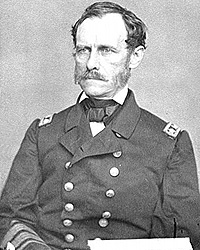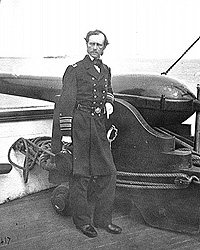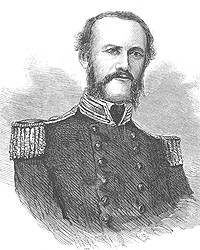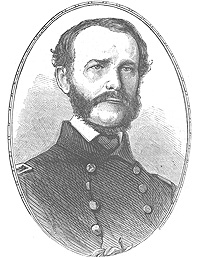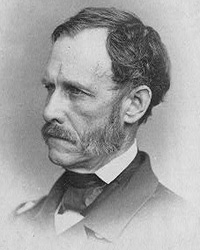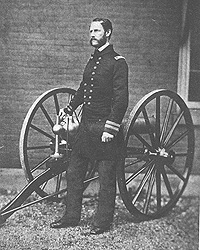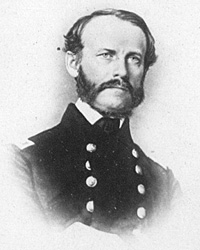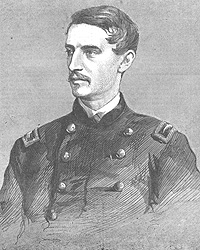President Lincoln “always delighted with the wise and witty sailor-talk of of [John A.] Dahlgren,”1 whom John Hay described as “the greatest brain, so far that the war has produced”.2
Dahlgren assumed command of the Washington Navy Yard in April 1861 when the Franklin Buchanan abandoned his office to join the Confederacy. Commander “Dahlgren shone in the new job. As a military position, Washington had no natural strength; it was vulnerable from every side,” wrote Dahlgren biographer Robert J. Schneller, Jr. Once the 71st New York Regiment took up residency at the Navy Yard, it became the frequent destination of Administration officials. “Dalhgren remained calm and worked hard, eating and sleeping in a room across the hall from his office. His kindness and courtesy impressed the men of the Seventy-first. He fed and quartered the troops and commanded ships in ferrying soldiers, accompanying transports, and patrolling the Potomac. He also received important visitors, including [Navy Secretary Gideon] Welles, Secretary of War Simon Cameron, and President Lincoln,” wrote Schneller.3
Over the next two years, Dahlgren was sought by Mr. Lincoln at critical military junctures. Their friendship prevented other naval officers from ousting him from his Navy Yard job and helped get him a sea command that ousted a senior officer, Admiral Samuel F. Du Pont. The Lincoln-Dahlgren collaboration came despite what biographer Schneller called differences in their personalities: “The president was quick with a joke and always ready to poke fun at himself. Dahlgren, quick to take offense at the slightest insult to his reputation, was as serious as Lincoln was jocular. He cared deeply about family and friends but was not someone to slap on the back and joke around with much.” But Schneller noted the two leaders shared a common interests in old machines and new inventions. “During the course of his friendship with Dahlgren, which would span his presidency, he would learn about the technology of taking life,” wrote Schneller.4 As commander of the Navy Yard Dahlgren regularly staged exhibitions of new weapons on Sunday afternoon – conveniently accompanied by lunch. A naval rival described these exhibitions as “champagne experiments.”5
When the ironclad Merrimack, renamed the Confederate Virginia, sunk Union ships in Hampton Roads in March 1862, panic struck in official Washington. “The Sec of War came in very much excited and walked up and down the room liked a caged lion. The Sec of Navy, of State, Gen. McClellan – Watson – Meigs – Totten – Com. Smith, and one or two more were sent for. The Presidents carriage being just ready he drove to the Navy Yard and brought up Capt Dahlgren,” wrote presidential aide John G. Nicolay.6 John Niven, biographer of Gideon Welles, wrote: “Sweeping up Senator Orville H. Browning, who had just arrived to pay a social call, Lincoln drove off to the Navy Yard. At 10:30 A.M., the marine orderly at the Commandant’s office announced that the President was at the door. Dahlgren went out to greet him and was asked to accompany Lincoln and Browning to the White House. ‘Poor gentleman,’ thought Dahlgren as he entered the carriage, ‘how thin and wasted he is.’ As the carriage sped north on Seventh Street, Lincoln said, ‘I have frightful news,’ and he related what he knew of the Merimack’s rampage at Hampton Roads. He did not rule out the possibility of the Merrimack appearing before Washington and shelling the city. Dahlgren was not reassuring – ‘such a thing might be prevented,’ he said. ‘If the Merrimack entered the river, it must be blockaded…all which could be done at present.'”7
There was considerable tension at the White House when they arrived. “For a little while there was a great flutter and excitement – the President being the coolest man of the party. There were all sorts of suggestions – all sorts of expressions of fear,” wrote presidential aide Nicolay.8 Presidential aide John Hay later reported that “To guard against the smallest possibility of danger the commandants of the harbor defenses at Boston and New York were ordered to stand to their guns, and Captain Dahlgren went cooly to work at our Navy Yard here to make the proper preparations to receive the bold rover courteously if she decided to visit the Capital.”9 According to biographer Schneller, Dahlgren was given authority over both army and navy resources to defend the capital from attack via the Potomac River. That night, Dahlgren took both Secretary of State William H. Seward and Secretary of the Army Edwin M. Stanton down the Potomac to examine what needed to be done. Dahlgren began to deploy stone-laden boats which were placed in the river to block it. That night, Captain Dahlgren wrote President Lincoln:
The proposed measures for guarding the Potomac are in progress. I am informed from the Quartermaster’s Dept that eight (8) Canal Boats loaded with stone were about to leave & eight (8) more would leave during the night. I have sent instructions to the Comdt of flotilla as to their disposition where the channel has least depth of water. The only eleven (11) inch gun and fifty (50) pounder which I have will be landed on Giesbury Point before midnight. The platforms will be laid and the Guns in position tomorrow morning The mortars will also be placed shot are being cast for all of them and a full supply – will be ready tomorrow. The Secretary of War has visited the defensive points & given me authority to draw on any of the Regiments or forts for men guns or munitions.
He has also authorized me to take for the while the private steamers plying on the river for present use of the Government & I have sent round for them. If there should be any use at all for a battery on Giesbury there ought to be twenty (20) of the heaviest cannon, shot of 170 pounds at 50 or 100 yards will be apt to do something. A smart steamer has been despatched to the mouth of the Potomac to observe it.10
Before he wrote the message, Dahlgren apparently did not have authority from Navy Secretary Welles, who as often happened, was annoyed by Dahlgren. Welles later wrote:
On the evening of that memorable Sunday, I received from Dahlgren, who was in command of the Navy yard, a message, stating that he, and all the force he could command, were employed in loading and preparing the boats which had been sent to the yard. He supposed by my order and with my approval, although he had received no word from me. I replied that I had purchased no boats, given no orders, and that if I, rightly apprehended the object and intention of the work in which he was engaged, I did not approve it. When I called on the President the next morning, Stanton was already there, stating some grievance, and, as I entered, he turned to me and inquired my reason for countermanding his orders. He proceeded to state that he had directed the purchase of all the boats that could be procured in Washington, Georgetown and Alexandria, which were being laden with stone and earth, under the direction of Colonel Meigs and Dahlgren, with a view of sinking them at Kettle Bottom Shoals, some fifty miles or more below, in order to prevent the ascension of the ‘Merrimac.’ That while the officers whom he had detailed, he supposed with my approval, were actively engaged, they had been suddenly stopped by an order from me to Dalhgren. He was still complaining when Dahlgren, and I believe Meigs also, came in, and I then learned that great preparations had been made to procure a fleet of boats, which were to be sunk at Kettle Bottom, to protect Washington. I objected, and said I would rather expend money to remove obstacles than to impede navigation; that the navy had labored through the fall and winter to keep open this avenue to the ocean; that the army had not driven the rebels from the Virginia shore, nor assisted us in this work, though they had been greatly benefited by our efforts of the transportation of their supplies, forage; that to our shame there was but a single railroad track to the Capital, though we had here an army of more than one hundred thousand to feed, and that I should not consent to take any of the naval appropriation to cut off water communication, unless so ordered by the President; but should protest against obstructing the channel of the river. Our conversation was very earnest, and the President attentively listened, but with an evident inclination to guard in every way against the ‘Merrimac,’ but yet unwilling to interrupt ocean communication, so essential to Washington. Giving the interview a pleasant turn, he said that it was evident that Mars not only wanted exclusive control of military operations (Stanton had manifested much dissatisfaction with McClellan as General-in-Chief,) but that he wanted a navy, and had begun to improve one. Having already got his fleet, the President thought he might as well be permitted to finish his work but he must not destroy communication on the Potomac, or cripple Neptune. The boats purchased might be loaded and sent down the river, but not sunk in the channel until it was known that the ‘Merrimac’ had entered the river, or was on its way hither. Whatever expense was incurred must be defrayed by the War Department. With this understanding, Dahlgren was authorized to supervise and assist Stanton’s squadron.11
A report that the Monitor had fought the Merrimack to a standstill led Welles to order a halt to the protective measures. Typically, when he heard that the Monitor’s commander had been wounded in battle, the ever ambitious Dahlgren sought unsuccessfully to take over his command.12
On more peaceful days, the Navy Yard was one of President Lincoln’s favorite destinations for relaxation. Presidential aide John Hay recorded that after a band recital at the Navy Yard in early May, 1861, the Presidential party “went down to the Pensacola and observed the shooting of the great Dahlgren gun Plymouth. Two ricochete shots were sent through the target and one plumper.” He reported that the President was “delighted” by the exhibition.13 Three months later, Hay wrote that after a White House visit, Prince Napoleon had gone to the navy yard where Dahlgren received him with a face as impassive as a wooden figure-head, and a brain as active as a high-pressure engine.” Dahlgren gave him a similar exhibition. President Lincoln’s fascination with ordnance matched Dahlgren’s and led to Dahlgren’s appointment as chief of the Navy Ordnance Bureau in January 1862. After one such trip to the Navy Yard in April 1863, Mr. Lincoln told Admiral Dahlgren: “Well I will go home….I had no business here; but, as the lawyer said, I had none anywhere else.”14
There were other adventures. Historian David Donald wrote: “To make sure [General Irvin McDowell understood his mission, the President went down to Aquia Creek, accompanied by Secretary Stanton and John A. Dahlgren, a naval officer to whom he had taken a great liking. When they reached the Potomac Creek, McDowell called their attention to a trestle bridge his men were erecting a hundred feet above the water in that deep and wide ravine. ‘Let us walk over,’ exclaimed the President boyishly, and though the pathway was only a single plank wide, he led the way. About halfway across Stanton became dizzy and Dahlgren, who was somewhat giddy himself, had to help the Secretary. But Lincoln, despite the grinding cares of his office, was in fine physical shape and never lost his balance.”15
Naturally, there was jealousy from naval officers, Navy Secretary Gideon Welles, and some civilian officials who thought Dahlgren spent too much time advancing his own interests. “Dahlgren was no stranger to cabinet officials, senators, and congressmen. He lived his life in daily contact with America’s political power elite. He knew the trend-setters of his day. He was one of them. And he had forged the ultimate political tool: a friendship with President Lincoln. Although he had not deliberately sought Lincoln’s friendship to further his quest for glory, he would not hesitate to use it for that purpose as their friendship grew,” wrote Schneller. Among those who found Dahlgren’s networking offensive was Iowa Senator James Grimes, who complained that Dahlgren was “the most conceited man in the Navy.”16
Unlike other generals or admirals posted outside of Washington, Dahlgren had no restrictions on access to the President – no matter how much it might annoy his nominal boss, Secretary of the Navy Welles. For example, when on April 27, 1862, Dahlgren heard rumors that Union forces had captured New Orleans, Dahlgren went directly to the White House. President Lincoln said, “There’s the dispatch, read it.”17 When he returned from a sea voyage, he naturally went to the White House. Dahlgren was a frequent enough visitor to write in his diary in 1863: “I observe that the President never tells a joke now.”18
Desk-bound Captain Dahlgren campaign endlessly to be promoted to admiral. William O. Stoddard painted this picture of how Dahlgren heard news of his promotion in January 1863 at a White House reception where Stoddard was clearly standing next to Mrs. Lincoln.
It is the middle reception room, below [The Blue Room], and it is an evening brilliant with uniforms. A slender, pleasant-faced gentleman, in full uniform as a naval officer, is chatting for a moment with Mrs. Lincoln, and then he turns, with the hearty freedom of something like old personal friendship, but before he can speak, your own hand goes out to him.
“Good evening, Admiral Dahlgren. How do you do?”
“What! Is that so? I had not expected it. I had not thought- ”
“The nomination went in late to-day, but it is all right, Admiral!”
“The President did it out of his own head,” he says, with a face flushed with pride and surprise.
“You are thinking of the way the boy made the fiddle, and he had wood enough left to make another?”
“You are not respectful to either the admiral or Mr. Lincoln -”
“Oh, yes, I am, Mrs. Lincoln, He has chosen the best kind of timber this time – real live-oak!”
The newly made admiral is really so affected that he bows and walks away, for he has been bitterly abused and misrepresented in some quarters, and this is the President’s verdict in his favor, closing the mouths of the detractors under whose attacks the gallant but sensitive sailor was writhing.”19
Biographer Schneller noted that “Dalhgren’s promotion precipitated a storm of indignation. In making him a rear admiral the president had circumvented not only Welles’s policy of advancing only those who had distinguished themselves in battle but also the naval tradition of basing promotion on sea service and seniority. Lincoln had essentially rewarded him for his ordnance work. While Dahlgren certainly deserved such an accolade, the navy was not yet ready to make admirals of nonfighters.”20
In July 1863, Dahlgren replaced Admiral Samuel Du Pont as commander of the Southern Atlantic Blockading Squadron fleet. It was a job that Dahlgren has sought months earlier and used most of his considerable connections to win. Du Pont had already been appointed and was affronted by Dahlgren’s efforts to replace him – charging that Dahlgren is a “diseased man on the subject of preferment and position.”21 Du Pont’s attack on Charleston with ironclads went badly, however and he was eventually replaced. Historian Allan Nevins wrote that Du Pont was “a brave and conscientious admiral, who…naturally chafed under an unwarranted sense of disgrace. For he held the conviction (one which naval colleagues shared) that he had been given improper orders to follow at Charleston, and that Secretary Welles had treated him badly.”22
The change was controversial. Du Pont was sacrificed for the failures of ironclads in attacking Charleston. Dupont’s good friend and frequent Administration antagonist – Congressman Henry Winter Davis – was infuriated by the switch and blamed Assistant Secretary of War Gustavus Fox and his brother-in-law, Postmaster-General Montgomery Blair, a Republican rival of Davis in Maryland. Nevertheless, Dahlgren finally got a chance to go to sea.
In part because of difficulties coordinating with his army counterpart, Dahlgren was unsuccessful in taking Charleston. “Dahlgren has not yet proved himself the brilliant officer which he was supposed to be, and his unfortunate sally by night upon the well-defended ruins of Sumter has not served to exalt his reputation much,” wrote journalist Noah Brooks in September. “The President believes in Dahlgren, and has every reason to believe that he will succeed when his occasion is fully come….”23 “Thousands upon thousands of rounds were poured upon [Fort Sumter],” wrote Allan Nevins. “Dahlgren finally gave up any idea of entering Charleston harbor with his ships.”24 He nevertheless remained in that job until the end of the war and provided critical communication with the army of General William T. Sherman once it reached Savannah in December 1864.
Meanwhile, Admiral Dahlgren’s son Ulric had joined the army and distinguished himself in several battles. Noah Brooks described Colonel Dahlgren in July 1863 “as brave and gallant a soldier as ever lived….Dahlgren went upon [General Alfred] Pleasonton’s staff when Hooker was relieved, and in a brilliant dash upon Williamsport, where he captured an invaluable rebel mail, he was wounded in the foot, and is now very low in health in consequence of the wound, and will lose his foot, if not worse.”25 Brooks clearly reflected a common White House opinion of the younger Dahlgren.
On February 1, 1864, Admiral Dahlgren visited Mr. Lincoln’s office with Ulric. Less than two weeks later, an incompetent Union cavalry officer, Judson Kilpatrick, also visited President Lincoln and Edwin Stanton. He apparently convinced them to authorize a cavalry raid of Richmond with the intention of liberating Union prisoners held there. Ulric Dahlgren helped lead the ambitious and ill-fated cavalry raid on Richmond. When he was reported killed in early March, presidential aide John G. Nicolay wrote: “He was decidedly the most gallant and daring cavalry officer of the war and his loss will be mourned here as widely and deeply almost as was Ellsworths…”26 Another presidential aide, John Hay wrote in his diary: “I was much shocked at hearing today of Ulric Dahlgren’s death. A great future cut off and a good fellow gone.”27
On Ulric’s body were found extensive memos about the raid, including references to killing Confederate President Jefferson Davis as one of the raid’s objectives. The objective and the memoranda were quickly disowned by Union leaders and labeled a forgery, particularly by Admiral Dahlgren. However, the authenticity of the captured documents was widely believed in the South and spurred discussion of similar plans – such as the one which John Wilkes Booth later employed to assassinate Mr. Lincoln.
Footnotes
- Michael Burlingame, editor, At Lincoln’s Side: John Hay’s Civil War Correspondence and Selected Writings, p. 133.
- Michael Burlingame, editor, Lincoln’s Journalist: John Hay’s Anonymous Writings for the Press,1860-1864, 1860-1864, p. 262 (May 11, 1862).
- Robert J. Schneller, Jr., A Quest for Glory: A Biography of Rear Admiral John A. Dahlgren, p. 182-183.
- Robert J. Schneller, Jr., A Quest for Glory: A Biography of Rear Admiral John A. Dahlgren, p. 185-186.
- Robert J. Schneller, Jr., A Quest for Glory: A Biography of Rear Admiral John A. Dahlgren, p. 225.
- Michael Burlingame, editor, With Lincoln in the White House: Letters, Memoranda, and Other Writings of John G. Nicolay, 1860-1865, p. 71 (Memorandum, February 20, 1862).
- John Niven, Gideon Welles: Lincoln?s Secretary of the Navy, p. 305.
- Michael Burlingame, editor, With Lincoln in the White House: Letters, Memoranda, and Other Writings of John G. Nicolay, 1860-1865, p. 74 (Journal entry, March 9, 1862).
- Michael Burlingame, editor, Lincoln’s Journalist: John Hay’s Anonymous Writings for the Press, 1860-1864, p. 231 (March 9, 1862).
- Abraham Lincoln Papers at the Library of Congress. Transcribed and Annotated by the Lincoln Studies Center, Knox College. Galesburg, Illinois. (Letter from John A. Dahlgren to Abraham Lincoln, March 9, 1862).
- Gideon Welles, “The First Iron-Clad Monitor”, The Annals of War, p. 29-30.
- Robert J. Schneller, Jr., A Quest for Glory: A Biography of Rear Admiral John A. Dahlgren, p. 198-199.
- Michael Burlingame and John R. Turner Ettlinger, editor, Inside Lincoln’s White House: The Complete Civil War Diary of John Hay, p. 21 (May 9, 1861).
- David Herbert Donald, Lincoln, p. 352.
- David Herbert Donald, Lincoln, p. 352 (Diary of John A. Dahlgren, February 6, 1863).
- Robert J. Schneller, Jr., A Quest for Glory: A Biography of Rear Admiral John A. Dahlgren, p. 245.
- John Niven, Gideon Welles: Lincoln’s Secretary of the Navy, p. 386.
- David Herbert Donald, Lincoln, p. 426.
- Michael Burlingame, editor, William O. Stoddard, Inside the White House in War Times, Memoirs and Reports of Lincoln’s Secretary, p. 127.
- Robert J. Schneller, Jr., A Quest for Glory: A Biography of Rear Admiral John A. Dahlgren, p. 234.
- Robert J. Schneller, Jr., A Quest for Glory: A Biography of Rear Admiral John A. Dahlgren, p. 232.
- Allan Nevins, The War for the Union: The Organized War to Victory, Volume IV, p. 31.
- Michael Burlingame, editor, Noah Brooks, Lincoln Observed: The Civil War Dispatches of Noah Brooks, p. 62 (September 23, 1863).
- Allan Nevins, The War for the Union: The Organized War to Victory, Volume IV, p. 32.
- Michael Burlingame, editor, Noah Brooks, Lincoln Observed: The Civil War Dispatches of Noah Brooks, p. 61 (July 22, 1863).
- Michael Burlingame, editor, With Lincoln in the White House: Letters, Memoranda, and Other Writings of John G. Nicolay, 1860-1865, p. 129 (Letter to Therena Bates, March 8, 1864).
- Michael Burlingame and John R. Turner Ettlinger, editor, Inside Lincoln’s White House: The Complete Civil War Diary of John Hay, p. 179 (March 12, 1864).
Visit
Elmer E. Ellsworth
Elmer E. Ellsworth (Mr. Lincoln’s White House)
Gustavus Fox (Mr. Lincoln’s White House)
William O. Stoddard
William O. Stoddard (Mr. Lincoln’s White House)
Gideon Welles (Mr. Lincoln’s White House)
Navy Yard (Mr. Lincoln’s White House)
The Sons
John Dahlgren (Mr. Lincoln’ White House)


